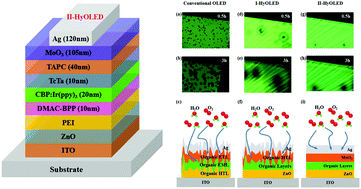An efficient and stable hybrid organic light-emitting device based on an inorganic metal oxide hole transport layer and an electron transport layer†
Abstract
At present, hybrid organic light-emitting devices (HyOLEDs) employing inorganic metal oxides as carrier injection/transport materials are widely studied because they are able to improve the poor stability of conventional devices. However, the stability can only be slightly improved by using a metal oxide as an electron transport layer as the base of the device. On the basis of the above-mentioned hybrid devices, we have successfully prepared a stable device by introducing an ultra-thick inorganic metal oxide MoO3 layer (105 nm) as a hole transport layer on top of the light-emitting layer to prevent erosion caused by moisture and oxygen in air. The luminance of the unpackaged device after storing in the atmosphere for 7 h is 8 times higher than that of conventional devices. In addition, due to the efficient hole injection ability and excellent carrier mobility of MoO3, even if the thickness of the device is significantly increased, the turn-on voltage is still lower than that of conventional devices. Moreover, electrons and holes are balanced in the device, so the efficiencies are significantly higher than those of conventional devices and HyOLEDs using inorganic metal oxides as electron transport layers.



 Please wait while we load your content...
Please wait while we load your content...